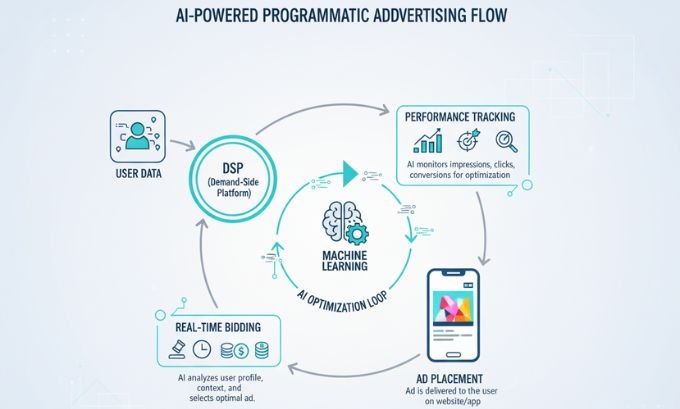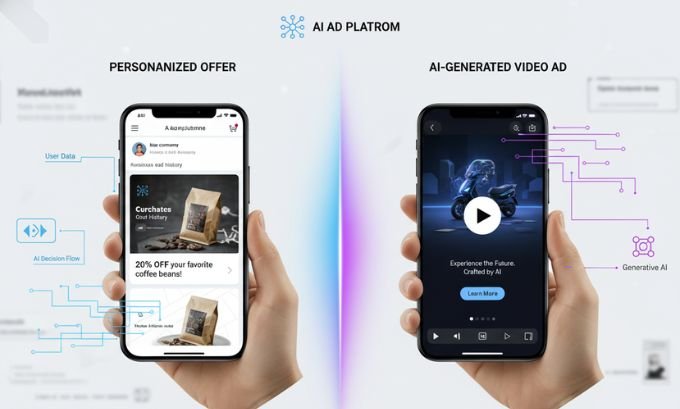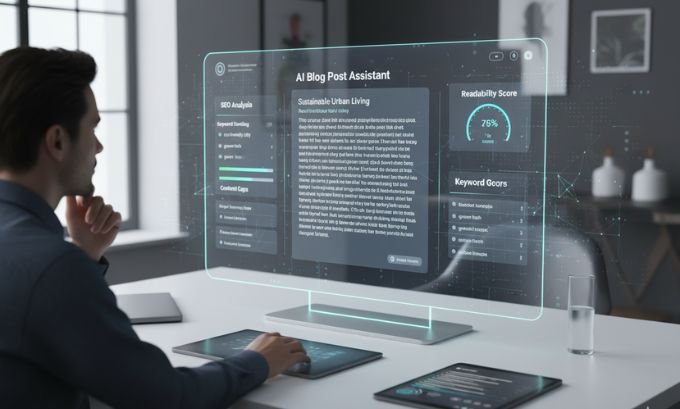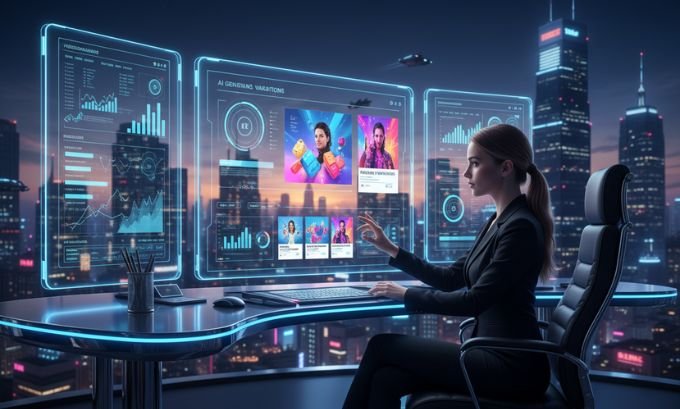Artificial intelligence (AI) is no longer a futuristic concept—it’s the engine powering modern digital advertising. If you’re wondering how to harness this power, you’ve come to the right place. By 2025, the strategic use of AI in digital advertising 2025 will define the gap between leading brands and their competitors. This technology provides a level of precision and efficiency that was once unimaginable, acting as a strategic partner for marketers worldwide.
This guide will show you exactly how to use AI in digital advertising in 2025. We will break down practical applications, from leveraging Machine Learning (ML) for smarter campaigns to implementing Programmatic Advertising for maximum efficiency. You’ll learn how to apply these technologies to enhance everything from Customer Personalization to your overall Content Marketing strategy.
Table of Contents
Understanding AI’s Role in Modern Digital Advertising
Artificial Intelligence (AI) is fundamentally about teaching machines to perform tasks that typically require human intellect. In digital advertising, this translates to analyzing data, predicting outcomes, and optimizing campaigns in real-time. By 2025, a solid grasp of AI is not just an advantage but a necessity for building successful advertising strategies. Its greatest strength lies in its ability to perform deep customer data analysis to deliver ads that are more relevant and effective.
The core technology driving this revolution is Machine Learning (ML). This is a subset of AI where algorithms learn directly from data without needing explicit programming. For an advertiser, this means your campaigns can get smarter over time, automatically. ML models analyze ad performance, spot patterns in consumer behavior, and tweak targeting parameters to maximize your return on investment (ROI). This cycle of continuous learning makes advertising more agile and responsive.
Practical Ways to Use AI in Your Ad Campaigns:
- Predictive Analytics: Use AI to forecast which ad creatives, audiences, and channels will yield the best results.
- Customer Personalization: Deliver unique ad experiences to individuals based on their real-time behavior and past preferences.
- Marketing Automation: Automate time-consuming tasks like ad bidding, budget management, and performance reporting.
- Smarter Ad Targeting: Identify and connect with niche audience segments with incredible accuracy.
A Real-World Scenario: Putting AI to Work in E-commerce
Let’s walk through how an online retailer selling eco-friendly home goods would use AI. In the past, they might have targeted a broad audience like “homeowners aged 30-50 interested in sustainable living.”
With the tools available for AI in digital advertising 2025, the strategy becomes far more sophisticated and effective.
- Gather Your Data: The first step is to connect your data sources. Your AI platform will ingest information from your website (browsing patterns, cart abandonments), purchase history from your CRM, social media engagement, and even public data on competitor trends.
- Use Predictive Segmentation: Apply Predictive Analytics to find high-value micro-segments. The AI might identify a group of users who not only follow sustainable living blogs but have also recently searched for “non-toxic cleaning supplies” and live in areas with strong environmental initiatives.
- Deploy Dynamic Creatives: Instead of showing everyone the same ad, you use AI to assemble personalized ads on the fly. A user who looked at a specific bamboo towel set sees an ad for that exact product. Someone who abandoned a cart with a water filter gets a reminder ad, perhaps with a small discount to encourage conversion.
- Automate Your Bidding: You set up a Programmatic Advertising campaign. The AI handles the real-time bidding, automatically paying more for ad placements that are highly likely to convert and less for those that aren’t.
This entire workflow is automated, freeing up your marketing team to focus on creative strategy and brand building instead of getting lost in manual campaign tweaks. The outcome is a more efficient, personalized, and profitable advertising campaign.
How to Implement AI-Powered Programmatic Advertising

Programmatic Advertising is simply the automated buying and selling of digital ad space. AI is what makes this process intelligent and effective. Instead of lengthy manual negotiations, algorithms bid on ad impressions in real-time auctions that occur in milliseconds. By 2025, understanding how to leverage this is key to scaling any Digital Marketing effort.
The system uses Machine Learning to decide which ad to show to which user, at what time, and for what price. It analyzes hundreds of signals—like user demographics, browsing behavior, location, and time of day—to calculate the value of a specific ad impression for your brand. This level of granular customer data analysis ensures your ad budget is spent with maximum efficiency.
How to Get Started with Programmatic AI:
- Choose a Demand-Side Platform (DSP): Platforms like Google Display & Video 360, The Trade Desk, or Adobe Advertising Cloud provide the interface to manage your programmatic campaigns.
- Define Your Audience: Use the platform’s tools to create your target audience. You can upload your own customer lists to create lookalike audiences, where the AI finds new users who share traits with your best customers.
- Set Your Campaign Goals and Budget: Define what you want to achieve (e.g., conversions, brand awareness) and set your budget. The AI will use this information to optimize its bidding strategy.
- Monitor and Refine: While the AI does the heavy lifting, it’s important to monitor performance. Use the analytics to understand what’s working and provide feedback to the system to refine its learning.
Strengths of This Approach
- Unmatched Efficiency: It automates a highly complex process, freeing up your team for strategic work.
- Pinpoint Precision: It allows you to target users with an accuracy that is impossible to achieve manually.
- Massive Scalability: You can run highly targeted campaigns across millions of websites and apps simultaneously.
Potential Challenges to Watch For
- Lack of Transparency: The “black box” nature of some AI algorithms can make it hard to understand why certain bidding decisions were made. Choose platforms that offer more transparency.
- Ad Fraud Concerns: While AI is great at detecting fraud, sophisticated bots can still mimic human behavior. Use platforms with robust, built-in fraud detection.
- Brand Safety Risks: Your ads could appear next to inappropriate content. Ensure you configure brand safety settings and use exclusion lists to protect your brand’s reputation.
Creating Hyper-Personalized Customer Experiences

Customer Personalization has evolved beyond using a customer’s name in an email. Thanks to AI, it’s now about creating genuinely unique and helpful experiences for every single user. By leveraging customer data analysis, AI algorithms can understand individual preferences and behaviors to deliver tailored ad content, product recommendations, and offers that feel personal and relevant.
Natural Language Processing (NLP) is a key technology here. NLP gives machines the ability to understand human language, allowing them to analyze customer reviews, social media comments, and support chats. This helps you gain deep insights into customer sentiment and intent, which you can then use to craft more personal and effective messaging.
How to Apply AI-Driven Personalization:
- Use Dynamic Creative Optimization (DCO): DCO platforms use AI to create thousands of ad variations by mixing and matching components like headlines, images, calls-to-action, and offers. The system then shows the best combination to each individual user based on their data profile.
- Implement AI-Powered Recommendation Engines: If you run an e-commerce site, use tools that analyze user behavior to provide personalized product recommendations. This is the same technology behind Netflix’s content suggestions and Amazon’s “Customers also bought” feature.
- Leverage AI in Email Marketing: Use Marketing Automation platforms with AI features to send personalized emails. The AI can determine the best time to send an email to each person and what content or products to feature in it.
Using Predictive Analytics to Guide Your Ad Strategy
Predictive Analytics involves using AI and Machine Learning to forecast future outcomes based on historical data. In digital advertising, this empowers you to make smarter, data-driven decisions. Instead of just reacting to campaign results, you can anticipate trends and proactively optimize your strategies before you even spend your budget.
To see how advanced personalization translates into product strategy, visit TokyoMart.store for AI-curated shopping and LinkLuminous.com for expert marketing automation services.
How to Use Predictive Analytics in Your Advertising:
- Prioritize Leads with Predictive Scoring: Implement an AI-powered lead scoring model. The system analyzes customer data to predict which leads are most likely to convert, allowing your sales and marketing teams to focus their efforts where it counts.
- Reduce Churn with Proactive Campaigns: Use AI to identify customers who are at risk of leaving. Once identified, you can automatically enroll them in targeted retention campaigns with special offers or helpful content to win them back.
- Forecast Customer Lifetime Value (LTV): AI models can forecast the total revenue a customer will generate. This helps you decide how much you should invest in acquiring different types of customers, optimizing your acquisition spend.
- Estimate Campaign Performance: Before launching a major campaign, use Predictive Analytics to estimate its potential reach, engagement, and conversion rates. This allows for more accurate budget planning and goal setting.
This forecasting capability is a game-changer for Digital Marketing. It shifts advertising from a reactive field to a proactive one, enabling your brand to stay ahead of the curve.
Upgrading Your Marketing Automation with AI
Marketing Automation platforms become exponentially more powerful when infused with AI. AI adds a layer of intelligence that enables these systems to make smart decisions and adapt on their own, moving beyond simple, rigid rules.
A traditional Marketing Automation workflow might be: “If a user downloads an e-book, send them a follow-up email in three days.” With AI, this becomes dynamic. The system might analyze a user’s behavior and decide that sending a push notification with a link to a related video would be more effective than another email.
Traditional vs. AI-Enhanced Automation: A Comparison
| Feature | Traditional Automation | How to Use AI-Enhanced Automation |
|---|---|---|
| Logic | Rule-based (If/Then) | Use predictive and adaptive logic that learns from user behavior. |
| Segmentation | Manual lists based on explicit data | Create dynamic segments that update automatically based on real-time actions. |
| Content | Static or pre-defined content blocks | Deliver dynamically generated, personalized content for each user. |
| Timing | Scheduled sends for entire lists | Send messages at the optimal time for each individual user to maximize open rates. |
| Lead Scoring | Points-based system for specific actions | Implement predictive scoring that focuses on conversion likelihood. |
This evolution allows you to create a more fluid and responsive customer journey, guiding users with the right message at the right time.
Leveraging AI for Content Marketing and SEO
The influence of AI in digital advertising 2025 also transforms Content Marketing and SEO. AI tools can now help you generate high-quality written content, optimize it for search engines, and even assist in creating video and image assets.

How to Use AI in Your Content Strategy:
- Accelerate Content Creation: Use tools powered by Natural Language Processing (NLP) to draft blog posts, ad copy, social media updates, and product descriptions. While a human editor is still essential for quality control and brand voice, these tools can dramatically speed up the writing process.
- Optimize Content for SEO: AI platforms can analyze massive datasets to identify content gaps on your site, discover trending topics, and recommend keywords. They can also perform technical SEO audits to find issues harming your ranking. For Content Marketing, AI can analyze existing articles and suggest improvements, like adding internal links or targeting related keywords to build topical authority.
Final Thoughts: A Practical Guide to AI in Advertising
The integration of AI in digital advertising in 2025 is a fundamental shift in the industry. To succeed, marketers must move from asking “What is AI?” to “How can I use AI?” By applying it to Programmatic Advertising, Customer Personalization, Predictive Analytics, and Content Marketing, you can achieve unparalleled results.
The key is to start small. Identify a specific challenge—like improving ad targeting or personalizing your email campaigns—and explore AI-powered tools that can solve it. Embrace a mindset of continuous learning and experimentation. Use AI not as a replacement for human creativity, but as a powerful partner that enhances your strategic capabilities.
Frequently Asked Questions (FAQ)
1. How can I start using AI in my digital advertising campaigns?
Start by choosing a specific goal, such as improving audience targeting. Explore AI features within platforms you already use, like Google Ads or Facebook Ads (e.g., Smart Bidding, lookalike audiences). Then, consider dedicated AI tools for tasks like Dynamic Creative Optimization or Predictive Analytics.
2. What are the best AI tools for digital advertising in 2025?
The best tool depends on your needs. For Programmatic Advertising, platforms like The Trade Desk and Google’s DV360 are leaders. For Content Marketing, tools like Jasper or Copy.ai can help with creation. For analytics, many CRM and Marketing Automation platforms now have built-in AI features.
3. What is an example of a company successfully using AI in advertising?
Amazon is a prime example. Its recommendation engine uses Machine Learning to analyze your browsing and purchase history to show you personalized product ads. This AI-driven Customer Personalization is a core part of its success.
4. Will AI take over advertising jobs?
AI is more likely to transform jobs than eliminate them. It automates data-heavy tasks, freeing up advertisers to focus on strategy, creativity, and client relationships. Future roles will require a blend of analytical skills to work with AI and creative skills to guide it.
5. What are the main benefits of using AI in my marketing efforts?
The primary benefits are increased efficiency through Marketing Automation, better ROI from more precise targeting, deeper customer insights from advanced customer data analysis, and the ability to deliver highly personalized experiences that boost engagement and conversions.
6. How is AI used in social media advertising?
Platforms like Meta (Facebook) and TikTok use powerful AI to run their ad systems. The AI optimizes ad delivery, determines the best audience for each ad, helps advertisers find new customers with lookalike audiences, and dynamically adjusts bids to achieve campaign goals.
7. What skills should I learn to stay relevant in an AI-powered advertising world?
Focus on developing a hybrid skillset. You’ll need strong analytical skills to interpret data from AI tools. Combine this with traditional marketing strengths like strategic thinking, brand storytelling, and understanding consumer psychology. Familiarity with various Digital Marketing and AI platforms is also critical.


